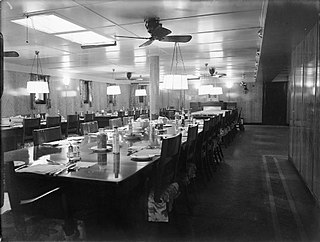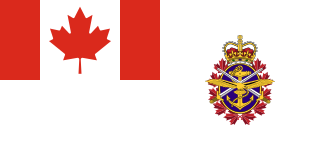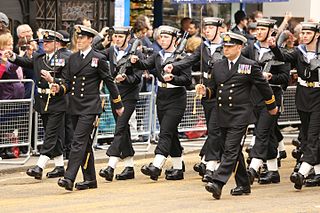
Grog is a term used for a variety of alcoholic beverages.

A cummerbund is a broad waist sash, usually pleated, which is often worn with single-breasted dinner jackets. The cummerbund was adopted by British military officers in colonial India, where they saw it worn by sepoys of the British Indian Army. It was adopted as an alternative to the waistcoat, and later spread to civilian use. The modern use of the cummerbund to Europeans and North Americans is as a component of the traditional black tie Western dress code.

Formal wear or full dress is the Western dress code category applicable for the most formal occasions, such as weddings, christenings, confirmations, funerals, Easter and Christmas traditions, in addition to certain state dinners, audiences, balls, and horse racing events. Generally permitted other alternatives, though, are the most formal versions of ceremonial dresses, full dress uniforms, religious clothing, national costumes, and most rarely frock coats. In addition, formal wear is often instructed to be worn with official full size orders and medals.

The wardroom is the mess cabin or compartment on a warship or other military ship for commissioned naval officers above the rank of midshipman. Although the term typically applies to officers in a navy, it is also applicable to marine officers and coast guard officers in those nations that have such service branches. On larger vessels, such as aircraft carriers of the United States Navy, there may be more than one wardroom. It may also be used on stone frigates to refer to similar officer mess facilities at naval, marine, and coast guard installations ashore.

The mess is a designated area where military personnel socialize, eat and live. The term is also used to indicate the groups of military personnel who belong to separate messes, such as the officers' mess, the chief petty officer mess, and the enlisted mess. In some civilian societies this military usage has been extended to the eating arrangements of other disciplined services such as fire fighting and police forces.

Service à la française is the practice of serving various dishes of a meal at the same time, with the diners helping themselves from the serving dishes. That contrasts to service à la russe in which dishes are brought to the table sequentially and served individually, portioned by servants.

Trafalgar Day is the celebration of the victory won by the Royal Navy, commanded by Vice-Admiral Horatio Nelson, over the combined French and Spanish fleets at the Battle of Trafalgar on 21 October 1805.

Mess dress uniform is the most formal type of evening-wear uniform used by military personnel, police personnel, and other uniformed services members. It frequently consists of a mess jacket, trousers, white dress shirt and a black bow tie, along with orders and medals insignia. Design may depend on regiment or service branch, e.g. army, navy, air force, marines, etc. In modern Western dress codes, mess dress uniform is the supplementary alternative equivalent to the civilian black tie for evening wear. Mess dress uniforms are typically less formal than full dress uniform, but more formal than service dress uniform.

A toast is a ritual during which a drink is taken as an expression of honor or goodwill. The term may be applied to the person or thing so honored, the drink taken, or the verbal expression accompanying the drink. Thus, a person could be "the toast of the evening", for whom someone "proposes a toast" to congratulate and for whom a third person "toasts" in agreement. The ritual forms the basis of the literary and performance genre, of which Mark Twain's "To the Babies" is a well-known example.
Semi-formal wear or half dress is a grouping of dress codes indicating the sort of clothes worn to events with a level of formality between informal wear and formal wear. In the modern era, the typical interpretation for men is black tie for evening wear and black lounge suit for day wear, corresponded by either a pant suit or an evening gown for women.

Personnel branches, in the Canadian Armed Forces (CAF), are groupings of related military occupations.

A state banquet is an official banquet hosted by the head of state in his or her official residence for another head of state, or sometimes head of government, and other guests. Usually as part of a state visit or diplomatic conference, it is held to celebrate diplomatic ties between the host and guest countries. Depending on time of the day, it may be referred to as a state dinner or state lunch. The size varies, but the numbers of diners may run into the hundreds.

The United States Marine Corps (USMC) prescribes several types of military uniform to distinguish its service members from other armed services, depending on the situation.
Red Sea rig, sometimes known as gulf rig or schooner rig, is a dress code for semi-formal evening events, which in general consists of black tie attire with the jacket removed, a red bow tie and red cummerbund, although there are local variations.

The uniforms of the Royal Navy have evolved gradually since the first uniform regulations for officers were issued in 1748. The predominant colours of Royal Navy uniforms are navy blue and white. Since reforms in 1997 male and female ratings have worn the same ceremonial uniform.

There are many customs and traditions associated with the Royal Navy of the United Kingdom. Many of these traditions have carried on to other Commonwealth navies, such as Canada, India, Australia and New Zealand. These include formal customs such as separate crests associated with ships, ensigns and fleet reviews. There are also several less formal customs and traditions, including Naval slang commonly referred to as Jack Speak and the traditional games of Uckers and Euchre.
The culture of the United States Marine Corps is widely varied but unique amongst the branches of the United States Armed Forces. Because members of the Marine Corps are drawn from across the United States, it is as varied as each individual Marine but tied together with core values and traditions passed from generation to generation of Marines. As in any military organization, the official and unofficial traditions of the Marine Corps serve to reinforce camaraderie and set the service apart from others. The Corps' embracement of its rich culture and history is cited as a reason for its high esprit de corps.

A loyal toast is a salute given to the sovereign monarch or head of state of the country in which a formal gathering is being given, or by expatriates of that country, whether or not the particular head of state is present. It is usually a matter of protocol at state and military occasions, and a display of patriotic sentiment at civilian events. The toast is usually initiated and recited by the host before being repeated by the assembled guests in unison; the composition varying between regions and types of gathering. There is sometimes a tradition of smashing a glass used for a loyal toast, so that no lesser toast can be made with it.
Hail and Farewell is a traditional military event whereby those coming to and departing from an organization are celebrated. This may coincide with a change in command, be scheduled on an annual basis, or be prompted by any momentous organizational change. It is a time to honor those who have departed the unit and thank them for their service. At the same time it is a welcome to those who are joining and introduces them to the special history and traditions of their new organization. This celebration builds organizational camaraderie and esprit de corps. It supports a sense of continuity through change.

Customs and etiquette in Chinese dining are the traditional behaviors observed while eating in Greater China. Traditional Han customs have spread throughout East Asia to varying degrees, with some regions sharing a few aspects of formal dining, which has ranged from guest seating to paying the bill.



















